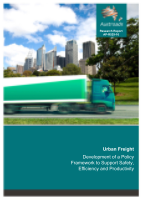Freight

Urban Freight: Development of a Policy Framework to Support Safety, Efficiency and Productivity
- Publication no: AP-R529-16
- ISBN: 978-1-925451-38-2
- Published: 29 September 2016
- PDF (free) Download
This report summarises the work undertaken and conclusions reached as part of an Austroads project to develop a policy framework to enhance the productivity, safety and efficiency of freight in the urban context.
This report includes: an international literature review of urban freight practices, initiatives and case studies which could be relevant for Australasian urban freight operations; industry and stakeholder views expressed at workshops and gathered using market research; assessment and prioritisation of possible initiatives; and an implementation plan.
- Summary
- Conclusions and Recommendations: Priority Initiatives and Implementation
- The Challenges of Implementation When Many Disparate Organisations and Groups Need to be Involved
- Assisting the Transport Industry and their Customers to be More Proactive
- Findings: Industry Consultation and Engagement
- Findings: Literature, Best Practice Review and Case Study Examples
- Glossary of Terms
- 1. Introduction
- 1.1. Background
- 2. Present Situation: The Urban Freight Task and Business Models Used
- 2.1. Business Models for Urban Freight
- 2.2. Assessing and Understanding the Urban Freight Task
- 2.3. Transport Modes
- 2.4. Data Issues in Freight Activity
- 2.4.1. Australia
- 2.4.2. New Zealand
- 2.5. Vehicle Types
- 2.5.1. Australia
- 2.5.2. New Zealand
- 2.6. Road Types
- 2.6.1. Australia
- 2.6.2. New Zealand
- 2.7. Freight Commodities and Format
- 2.8. Freight Policies and Strategies
- 3. Literature, Best Practice and Case Study Example Review
- 3.1. Broader Contextual Policy Frameworks
- 3.2. Physical Infrastructure
- 3.2.1. Transport Infrastructure Based Initiatives
- 3.2.2. Freight Building Initiatives: Warehouses and Freight Centres
- 3.3. Transport Modes Other Than Road
- 3.3.1. Rail
- 3.3.2. Seaports
- 3.3.3. Airports
- 3.3.4. Road Rail Intermodal Hubs
- 3.3.5. Waterways
- 3.3.6. Fixed Infrastructure (Pipelines, Conveyors Etc.)
- 3.4. Transport Equipment
- 3.4.1. Trucks
- 3.4.2. Materials Handling
- 3.5. Operational Initiatives and Changes at Company Level
- 3.5.1. Software Initiatives Such as Routing and Scheduling Systems
- 3.5.2. Initiatives to Increase Equipment Utilisation Such as Double Shifting and Overnight Operations
- 3.6. Commercial Initiatives at Intercompany or Network Level
- 3.6.1. Software Systems to Align Freight Service Users and Providers (e.g. Backloading Offering and Seeking Systems)
- 3.7. Governance and Regulatory Initiatives
- 3.7.1. Pricing and Charging Schemes
- 3.7.2. Environmental Zones
- 3.7.3. Loading, Mass and Dimensions Type Initiatives
- 3.7.4. Time of Day Regulations and Curfews
- 3.7.5. Guidance and Advisory Panels
- 3.7.6. Heavy Vehicle Regulator Initiatives
- 3.8. Implementation Frameworks
- 3.9. Summary
- 4. Stakeholder and Industry Consultation
- 4.1. Approach
- 4.2. Method
- 4.2.1. Industry Workshops
- 4.2.2. Market Research
- 4.3. Identified Urban Freight Issues
- 4.4. Discussion of Initiatives with Stakeholders
- 4.4.1. Workshops
- 4.4.2. Market Research Interviews
- 4.4.3. Infrastructure Improvements
- 4.4.4. Transport Modes for Freight
- 4.4.5. Transport Equipment
- 4.4.6. Operational Initiatives
- 4.4.7. Governance and Regulatory Initiatives
- 4.5. Findings and Common Themes from Industry Consultation and Stakeholder Engagement
- 4.5.1. Context
- 4.5.2. Summary of Findings from Industry and Stakeholder Consultation
- 5. Assessment and Prioritisation of Initiatives: Reference Group Workshop
- 5.1. Findings from Prioritisation Exercise
- 5.2. Implications for Government Policies and Measures
- 5.3. Evaluation of Interventions
- 6. Implementation Plan
- 6.1. Initiative Areas
- 6.2. Applicability and Deliverability of Initiatives
- 6.3. Implementation Planning
- 6.3.1. Harnessing the Combined Strength from Multiple, Disparate Organisations and Groups
- 6.4. Assisting the Transport Industry and their Customers to be More Proactive
- 6.5. Overall Implementation Plan
- Appendix A Workshop Agenda – Auckland, Adelaide, Perth
- Appendix B Stakeholders Consulted
- Auckland New Zealand – Workshop
- Adelaide South Australia – Workshop
- Perth Western Australia – Workshop
- Melbourne Victoria – Market research (telephone)
- Queensland – Market research (telephone)
- Sydney New South Wales – Market research (telephone)
- Appendix C Urban Freight Initiatives Assessment Tool Used at Workshops
- Appendix D Workshop Notes
- Appendix E Melbourne City Council CBD Freight Vehicle Study Summary
- Appendix F Market Research Discussion Checklist
- Appendix G Market Research Findings
- G.1 Sydney
- G.2 Market Research Findings – Brisbane and South Eastern Queensland
- G.3 Market Research Findings – Melbourne
- Appendix H Day vs Night Wage Cost Assessment
- Appendix I Industry Action to Support Identified Initiatives
- References
Related publications
WEB-Telematics-Framework-23
WEB-PROJECTS-23
Latest Freight News
